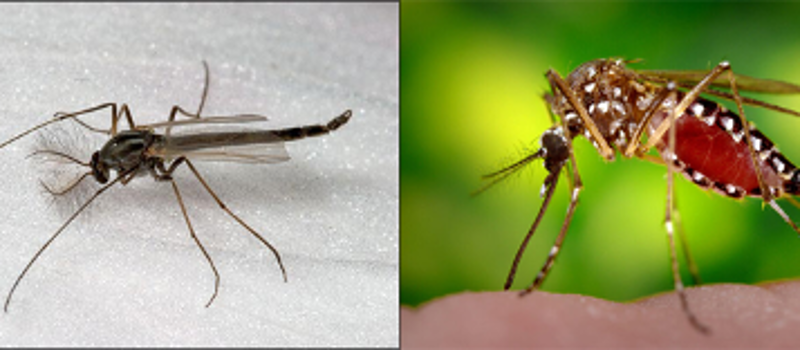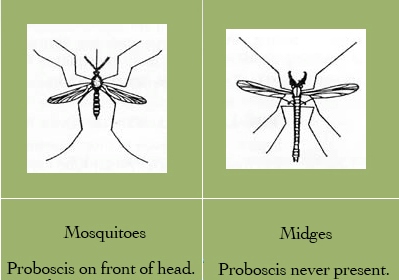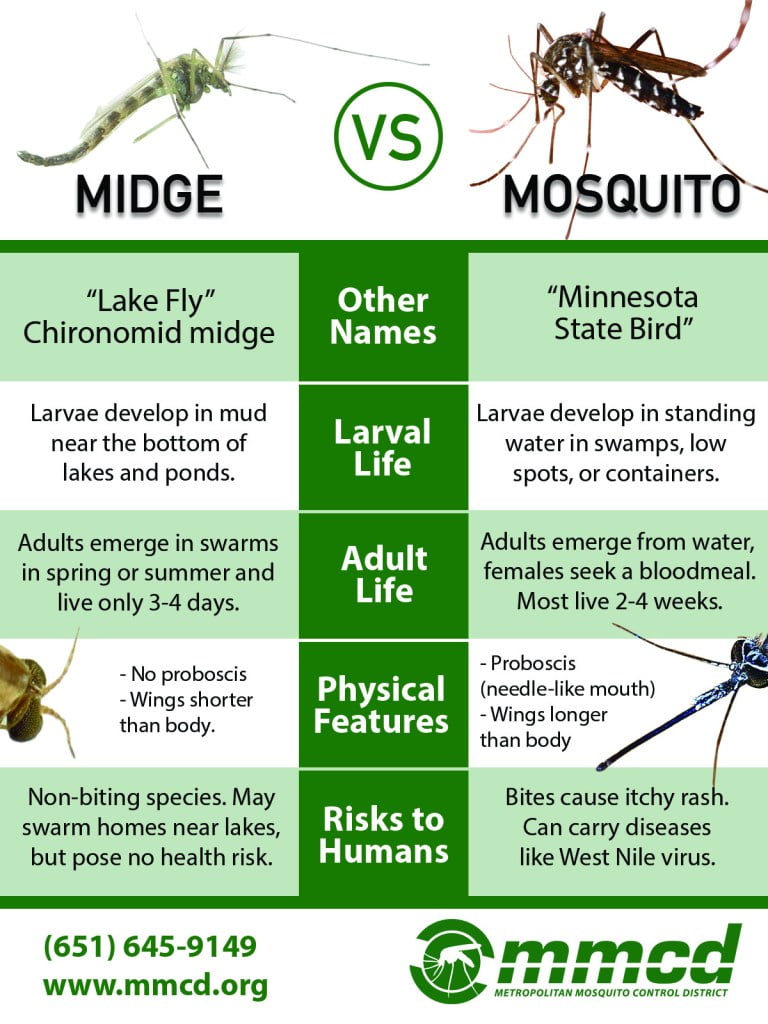Mosquitoes inject a syringe-like tube to drain blood, while biting midges cut skin open with special cutters. Midges are generally less harmful and deadly compared to mosquitoes.
Midges fly in swarms that resemble clouds, while mosquitoes do not always fly in swarms due to their faster flight. Additionally, midges are known to hatch in large groups and swarm as they seek a mate, living for only a few days without biting.
On the other hand, mosquitoes can be carriers of diseases and are more commonly associated with biting humans for blood meals. Understanding the differences between mosquitoes and midges can help in identifying and managing these pesky insects effectively.

Credit: www.mosquitosquad.com
Introducing The Insects
Distinguishing Features
Mosquitoes and midges are both small flying insects, but they have distinct characteristics that set them apart.
Habitat Preferences
Mosquitoes tend to thrive in areas with standing water, such as ponds and marshes, while midges are commonly found near bodies of water like lakes and rivers.
Physical Characteristics
When it comes to understanding the differences between mosquitoes and midges, examining their physical characteristics is crucial. From size and shape to wing patterns, these factors play a significant role in distinguishing between the two.
Size And Shape
- Typically larger and more robust
- Long, slender bodies
- Distinctive elongated proboscis (sucking mouthpart)
- Smaller and more delicate in comparison
- Short, stocky bodies
- Lack the elongated proboscis
Wing Patterns
- Wings adorned with scales, resembling fringe or fine hairs
- Distinctive wing patterns
- Varied wing sizes
- Wings resembling barren panes of glass
- Lack of scales on the wings
- Uniform wing sizes
Feeding Habits
Both mosquitoes and midges are small flying insects known for their annoying bites, but they differ in their feeding habits.
Mouthparts And Biting Behavior
Mosquitoes have elongated, needle-like mouthparts called proboscis, which they use to pierce the skin and suck blood. Midges, on the other hand, have mouthparts that resemble tiny scissors, which they use to cut the skin and feed on the resulting blood.
Dietary Differences
Mosquitoes primarily feed on blood, using it as a source of protein for egg production. Some species also consume nectar from flowers. In contrast, midges have a more varied diet, feeding on nectar, decaying plant matter, and other small insects.
Life Cycle And Reproduction
Understanding the life cycle and reproduction of mosquitoes and midges sheds light on their unique characteristics.
Mating Rituals
Mosquitoes engage in complex mating rituals, where males form swarms to attract females. Female mosquitoes choose mates based on the quality of their swarming behavior.
Lifespan Variations
Midges are known to hatch in large groups and swarm as they seek a mate. They don’t bite and they only live for a few days, contrasting with mosquitoes which have a longer lifespan.
Behavioral Traits
Mosquitoes and midges differ in their biting techniques – mosquitoes use a syringe-like tube, while midges cut the skin with special mouth cutters. Mosquito bites are quicker but less painful, while midge bites can be more painful and last longer due to the deeper cut.
Swarming Patterns
One of the primary differences between mosquitoes and midges is their swarming patterns. Mosquitoes tend to swarm in a specific location, usually near standing water, where they lay their eggs. They also tend to bite humans and other animals during the evening and nighttime hours. On the other hand, midges have a more erratic swarming pattern. They are known to hatch in large groups and swarm as they seek a mate. However, unlike mosquitoes, midges do not bite and only live for a few days.Flight Speed And Ability
Mosquitoes and midges also have different flight speed and ability. Mosquitoes are known for their quick and agile flight, making them difficult to catch and swat away. They are also capable of flying long distances to find a suitable host for their blood meal. Midges, on the other hand, have a slower and more erratic flight pattern. They are not as agile as mosquitoes and tend to fly in short, quick bursts. Additionally, midges are not known to fly long distances and tend to stay within a few miles of their hatching location.Overall, understanding the behavioral traits of mosquitoes and midges can help in identifying and managing these pests. While both can be a nuisance, mosquitoes are known to transmit diseases, making them a more serious health concern. Proper mosquito control measures, such as eliminating standing water and using repellents, can help prevent their spread. On the other hand, midges are harmless and do not require any specific control measures.
Credit: www.washoecounty.gov
Environmental Impact
When it comes to the environmental impact of mosquitoes and midges, these tiny insects play important roles in ecosystems and can also pose challenges for human interaction and nuisance. Let’s explore how mosquitoes and midges differ in their environmental impact.
Role In Ecosystems
Mosquitoes and midges both serve as essential food sources for various organisms in aquatic and terrestrial ecosystems. Their larvae provide sustenance for fish, amphibians, and other aquatic animals, contributing to the intricate web of life in these environments. Additionally, adult mosquitoes and midges are prey for insectivorous birds, bats, and other predators, further emphasizing their role in the food chain.
Human Interaction And Nuisance
- Carry diseases such as malaria, dengue fever, and Zika virus
- Cause discomfort and irritation with their bites
- Trigger allergic reactions in some individuals
- Primarily cause nuisance through their biting behavior
- May result in painful lesions for some people
- Can be a source of annoyance during outdoor activities
Health Concerns
Mosquitoes and midges may look similar, but there are key differences between them. Mosquitoes inject a tube into the skin to draw blood, while midges cut the skin with their mouths, causing more damage and longer-lasting bites. Understanding these distinctions can help in managing health concerns related to their bites.
Disease Transmission
Mosquitoes are notorious for transmitting diseases such as malaria, dengue fever, Zika virus, and West Nile virus. These diseases can have severe and even fatal consequences for humans. On the other hand, midges are not known for transmitting diseases to humans, and their bites are generally considered to be more of a nuisance than a health risk.
Allergic Reactions
Some individuals may experience allergic reactions to mosquito bites, which can manifest as swelling, redness, and itching at the bite site. In severe cases, allergic reactions to mosquito bites can lead to anaphylaxis, a life-threatening condition. In contrast, midge bites are known to cause intense itching and discomfort, but they are less likely to trigger severe allergic reactions compared to mosquito bites.

Credit: mmcd.org
Prevention And Control
Mosquitoes and midges differ in their biting technique. Mosquitoes use a syringe-like tube to draw blood, while midges cut the skin, causing more damage and longer-lasting bites. Additionally, midges are attracted to certain scents and can cause painful lesions.
Prevention and Control:Protective Measures: To prevent mosquito and midge bites, protective measures must be taken. Mosquitoes are most active at dawn and dusk, so it is advised to wear long-sleeved shirts and pants, especially during these times. Mosquitoes are attracted to dark colors, so it is best to wear light-colored clothing. Insect repellents containing DEET, picaridin, or oil of lemon eucalyptus can be applied to exposed skin and clothing to repel both mosquitoes and midges.Eradication Techniques: The best way to control mosquito and midge populations is to eliminate their breeding grounds. Mosquitoes lay their eggs in standing water, so it is important to regularly empty any containers that may hold water, such as flower pots, bird baths, and gutters. Mosquitoes can also breed in stagnant ponds and ditches, so it is important to maintain proper drainage and keep grass and weeds trimmed. Midges, on the other hand, breed in moist soil, so it is important to remove any decaying plant matter and maintain a dry environment.In addition to eliminating breeding grounds, insecticides can also be used to control mosquito and midge populations. Larvicides can be applied to standing water to kill mosquito larvae before they hatch. Adulticides can be sprayed to kill adult mosquitoes and midges. However, it is important to use these chemicals responsibly and follow all safety precautions.Frequently Asked Questions
Are Midge Bites Worse Than Mosquito Bites?
Midge bites are worse than mosquito bites as they cause more damage by cutting the skin open, leading to longer-lasting pain.
How Do You Tell If You Have Midges?
To identify midges, look for dark brown coloring, bodies extending beyond wings, and stocky fly appearance with short wings.
Why Am I Getting Bitten By Midges?
Midges are attracted to certain people more than others due to various factors like body odor and skin chemicals.
Conclusion
Understanding the differences between mosquitoes and midges can help you identify and manage them better. Mosquitoes bite with a syringe-like tube, while midges cut the skin. Knowing these distinctions can aid in prevention and treatment strategies for their bites. Stay informed and protected!
Related posts:

I’m MD Tanvir, and I bring years of expertise gained from working closely with pest control companies to the forefront. My journey in the industry has inspired me to launch Bug Battler, a platform aimed at equipping people with the know-how to combat pests autonomously. Through Bug Battler, I aim to empower individuals with practical insights to tackle pest infestations effectively.

